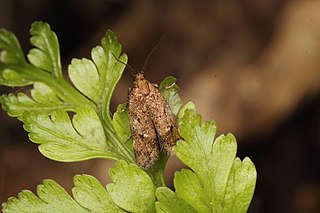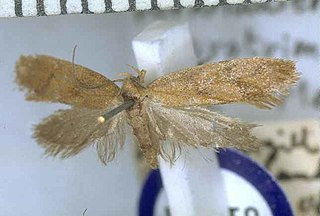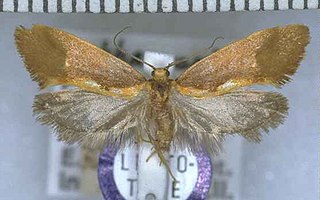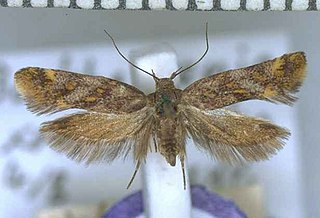
Tingena anaema is a species of moth in the family Oecophoridae. It is endemic to New Zealand and has been collected at Lake Wakatipu, Invercargill and Stewart Island / Rakiura. The adults of the species are on the wing in December.

Tingena aphrontis is a species of moth in the family Oecophoridae. It is endemic to New Zealand and has been collected at altitudes between 3000 - 5000 ft at Arthur's Pass and Mount Arthur. The species lives in open alpine habitat amongst alpine vegetation. Adults of the species are on the wing in January.

Tingena compsogramma is a species of moth in the family Oecophoridae. It is endemic to New Zealand and has been observed in the North and South Islands. This species inhabits native forest and adults are on the win from December until March.

Tingena eriphaea is a species of moth in the family Oecophoridae. It is endemic to New Zealand and has been found in Otago. This species is known to inhabit native beech forest.

Tingena falsiloqua is a species of moth in the family Oecophoridae. It is endemic to New Zealand and has been collected in the North Island. This species frequents subalpine native forest.

Tingena fenestrata is a species of moth in the family Oecophoridae. It is endemic to New Zealand and has been observed in the South Island. This species has been observed in native forest habitat in December.

Tingena horaea is a species of moth in the family Oecophoridae. It is endemic to New Zealand and have been observed in both the North and South Islands. The adults are on the wing in January.

Tingena idiogama is a species of moth in the family Oecophoridae. It is endemic to New Zealand and has been observed on the slopes of Mount Taranaki. Its preferred habitat is native subalpine scrub and adults are on the wing in January.

Tingena letharga is a species of moth in the family Oecophoridae. It is endemic to New Zealand and has been observed in Otago. Adults are on the wing in December and January.

Tingena maranta is a species of moth in the family Oecophoridae. It is endemic to New Zealand and is found in the lower South Island. Adults of this species are on the wing from October until January. This species perfers grass or low herb habitat. Unlike its close relatives it does not inhabit native forest.

Tingena melanamma is a species of moth in the family Oecophoridae. It is endemic to New Zealand and has been observed in Marlborough, Otago and Southland.

Tingena monodonta is a species of moth in the family Oecophoridae. It is endemic to New Zealand and has been found in both the North and South Islands. This species inhabits native beech forest at altitudes of between 2500 - 3000 ft. The adults of the species are on the wing from November and December.

Tingena nycteris is a species of moth in the family Oecophoridae. It is endemic to New Zealand and has been observed in the North and South Islands. This species inhabits native forest and scrubland and adults are on the wing from October to January.

Tingena oxyina is a species of moth in the family Oecophoridae. It is endemic to New Zealand and has been observed in the Otago region. This species inhabits native beech forest at altitudes of between 1000 - 3000 ft. Adults of this species are on the wing in January.

Tingena paratrimma is a species of moth in the family Oecophoridae. It is endemic to New Zealand and has been observed in the lower parts of the South Island. George Hudson regarded this species are uncommon. The adults of this species are on the wing from November to February.

Tingena pharmactis is a species of moth in the family Oecophoridae. It is endemic to New Zealand and has been observed in the Nelson, Tasman and Wellington regions. The adults of this species are on the wing in December.

Tingena phegophylla is a species of moth in the family Oecophoridae. It is endemic to New Zealand and has been observed in the southern parts of the South Island. This species inhabits native beech forest. The adults of this species are on the wing in December.

Tingena robiginosa is a species of moth in the family Oecophoridae. It is endemic to New Zealand and has been observed in the southern parts of the South Island. It has been observed in subalpine habitats at altitudes of between 2700 and 3500 ft amongst Hebe and Cassinia species. The adults of this species are on the wing in December and January.

Tingena thalerodes is a species of moth in the family Oecophoridae. It is endemic to New Zealand and has been found at Arthur's Pass. This species inhabits rough herbage on mountain sides. Adults are on the wing in December and January.

Tingena xanthomicta is a species of moth in the family Oecophoridae. It is endemic to New Zealand and has been found in both the North and South Islands. This species inhabits native scrub on hillsides and appears to be attracted to Coprosma areolata. Adults are on the wing from November until February.





















